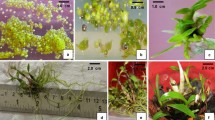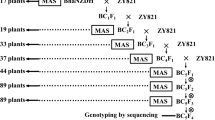Abstract
A series of crosses designed for introgression of mandarin (Citrus reticulata Blanco) and pummelo (C. maxima Merr.) germplasm, to develop an alternative rootstock to sour orange (C. aurantium L.), were carried out. It is necessary to identify those hybrids that yield nucellar seedlings for rootstock propagation. Rootstocks can be developed through traditional plant breeding methods; however, the ability to screen and select for economically important traits (such as production of true nucellar seedlings) in an efficient fashion is limited by the difficulties of screening techniques based on whole plant performance. To address these problems, we have used randomly amplified polymorphic DNA (RAPD) and fluorescently labeled expressed sequence tag simple sequence repeat (EST-SSR) molecular markers. A total of 204 individual seedlings obtained from 34 hybrid parental plants were successfully characterized using five RAPD primers. Ten hybrid parents and their progenies, found to be genetically similar among themselves, were selected for more scrutiny using eight EST-SSR primer pairs. The degrees of genetic similarity (nucellars) among progeny seedlings were determined and compared with that of their parents. The mean genetic similarity varied from 67–99% among the selected rootstock candidates screened. The genetic similarity relationship identified using RAPD and EST-SSR molecular markers was highly concordant (p = 0.001). Two elite rootstock candidates (B6R5T56; B6R11T129) that seem to be ideal for future mandarin and pummelo derived rootstock breeding programs have been identified. Our results indicate that either RAPD or EST-SSR analyses could be equally successful in identifying true nucellars among the progenies obtained from introgression crosses of mandarin and pummelo, thus improving the accuracy of early selection in a citrus rootstock breeding program.






Similar content being viewed by others
References
Andrade-Rodriguez M, Villegas-Monter A, Carrillo-Castaneda CG, Garcia-Velazquez A (2004) Polyembryony and identification of Volkamerian lemon zygotic and nucellar seedlings using RAPD. Pesqui Agropecu Bras Brasilia 39:551–559
Andrade-Rodriguez M, Villegas-Monter A, Gutierrez-Espinosa A, Carrillo-Castaneda G, Garcia-Velazquez A (2005) Polyembryony and RAPD markers for identification of zygotic and nucellar seedlings in Citrus. Agrociencia 39:371–383
Applied Biosystems (2001a) GeneScan Analysis ver. 3.7 NT software user guide, ABI Prism 3100 Genetic Analyzer, Foster City, CA
Applied Biosystems (2001b) ABI Prism Genotyper ver. 2.5 NT software user’s manual, Foster City, CA
Ashari S, Aspinall D, Sedgley M (1988) Discrimination of zygotic and nucellar seedlings of five polyembryonic citrus rootstocks by isozyme analysis and seedling morphology. J Am Soc Hortic Sci 63:695–703
Bar-Joseph M, Roistacher CN, Garnsey SM, Gumpf DJ (1981) A review of tristeza, an ongoing threat to citriculture. Proc Int Soc Citricul 1:419–423
Bar-Joseph M, Marcus R, Lee RF (1989) The continuous challenge of citrus tristeza virus control. Annu Rev Phytopath 27:291–316
Barrett HC, Rhodes AM (1976) A numerical taxonomic study of affinity relations in cultivated citrus and its close relatives. Syst Bot 1: 105–136
Bastianel B, Schwardz SF, Filho CHD, Lin LL, Machado M, Koller OC (1998) Identification of zygotic and nucellar tangerine seedlings (Citrus spp.) using RAPD. Gen Mol Biol 21:123–127
Cameron JW, Soost RK (1969) Mono and polyembryony among tetraploid citrus hybrids. HortScience 15:730–731
Castle WS (1987) Citrus rootstocks. In: Rom RC, Carlson RF (eds) Rootstocks for fruit crops. Wiley, New York, pp 361–399
Chen C, Zhou P, Choi YA, Huang S, Gmitter FG Jr (2006) Mining and characterizing microsatellites from citrus ESTs. Theor Appl Genet 112:1248–1257
Chen C, Bowman KD, Choi YA, Phat D, Nageswara Rao M, Huang S, Soneji JR, McCollum G, Gmitter FG Jr (2007) EST-SSR genetic maps for Citrus sinensis and Poncirus trifoliata. Tree Genet Genom (in press). DOI 10.1007/s11295-007-0083-3
Corazza-Nunes MJ, Machado MA, Nunes WMC, Cristofani M, Targon MLPN (2002) Assessment of genetic variability in grapefruits (Citrus paradisi Macf.) and pummelos (C. maxima Merr.) using RAPD and SSR markers. Euphytica 126:169–176
Davies FS, Albrigo LG (1994) Citrus. CABI, Wallingford, UK
Deng Z, Huang S, Gmitter FG Jr (1996) Simple and quick procedure for preparing citrus genomic DNA for PCR analysis. Proc Int Soc Citricul 2:841–844
Esen A, Soost RK (1974) Inheritance of browning of young-shoot extracts of Citrus. J Heredity 65:97–100
Frost HB (1943) Genetics and breeding. In: Webber HJ, Batchelor LD (eds) The Citrus Industry, vol 1. University of California Press, Berkeley, CA, USA, pp 817–913
Furr JR, Reece PC (1946) Identification of hybrid and nucellar citrus seedlings by a modification of the rootstock color test. Proc Am Soc Hortic Sci 48:141–146
Garcia R, Asins MJ, Forner J, Carbonell EA (1999) Genetic analysis of apomixis in Citrus and Poncirus by molecular markers. Theor Appl Genet 99:511–518
Gmitter FG Jr, Chen C, Nageswara Rao M, Soneji JR (2007) Citrus fruits. In: Kole CR (ed) Fruits and nuts, genome map** & molecular breeding in plants, vol 4. Springer, Heidelberg, pp 265–279
Grosser JW, Medina-Urrutia V, Ananthakrishnan G, Serrano G (2004) Building replacement sour orange rootstocks: somatic hybridization of selected mandarin + pummelo combinations. J Am Soc Hortic Sci 129(4):530–534
Hodgson RW (1967) Horticultural varieties of citrus. In: Reuther W, Webber HJ, Batchelor LD (eds) The Citrus Industry, vol 1. University of California Press, Berkeley, CA, USA, pp 431–591
Moore GA, Castle WS (1988) Morphology and isozymic analysis of open-pollinated citrus rootstock populations. J Hered 799:59–63
Morgante M, Olivieri AM (1993) PCR-amplified microsatellite as markers in plant genetics. Plant J 3:175–182
Nassar NMA, Collevatti RG (2005) Microsatellite markers confirm high apomixis level in cassava bred clones. Heriditas 142:33–37
Nei M (1973) Analysis of gene diversity in subdivided populations. Proc Natl Acad Sci USA 70:3321–3323
Nicolosi E, Deng ZN, Gentile A, La Malfa S, Continella G, Tribulato E (2000) Citrus phylogeny and genetic origin of important species as investigated by molecular markers. Theor Appl Genet 100:1155–1166
Oliveira CA, Garcia AN, Cristofani M, Machado MA (2002) Identification of citrus hybrids through the combination of leaf apex morphology and SSR markers. Euphytica 128:397-403
Pieringer AP, Edwards GJ (1967) Identification of nucellar and zygotic citrus seedlings by infrared spectroscopy. Proc Am Soc Hortic Sci 86:226–234
Roose ML, Traugh SN (1988) Identification and performance of citrus trees on nucellar and zygotic rootstocks. J Am Soc Hortic Sci 113:100–105
Ruiz C, Breto MP, Asins MJ (2000) A quick methodology to identify sexual seedlings in citrus breeding programs using SSR markers. Euphytica 112:89–94
Siegel S, Castellan NJJ (1988) Nonparametric statistics for the behavior sciences. McGraw-Hill Book, New York
Sneath PH, Sokal RR (1973) Numerical Taxonomy: the principles and practice of numerical classification. Freeman WH and Co., San Francisco, USA
Spiegel-Roy P, Vardi A, Shani A (1977) Peroxidase isozymes as a tool for early separation of nucellar and zygotic citrus seedlings. Proc Int Soc Citricul 2:619–924
Statsoft (1993) Statistica ver 4.5. Statsoft, USA
Tautz D (1989) Hypervariability of simple sequences as a general source of polymorphic DNA markers. Nucl Acid Res 17:6463–6471
Tusa N, Abbate L, Ferrante S, Lucretti S, Scarano MT (2002) Identification of zygotic and nucellar seedlings in citrus interploid crosses by means of isozymes, flow cytometry and ISSR-PCR. Cell Mol Biol Lett 7:703–708
Weinbaum SA, Cohen E, Spiegel-Roy P (1982) Rapid screening of ‘Satsuma’ mandarin progeny to distinguish nucellar and zygotic seedlings. HortSci 17:239–240
**ang C, Roose ML (1988) Frequency and characteristic of nucellar and zygotic seedlings in 12 citrus rootstocks. Sci Hortic 37:47–59
Yeh FC, Yang RC, Boyle T (1999) POPGENE, ver. 1.31. CIFOR and Univ. of Alberta, Edmonton, Alberta, Canada
Yokomi RK, Lastra R, Stoetzel MB, Amsteegt RF, Lee SM, Garnsey TR, Gottwald MA, Rocha-Pena, Niblett CL (1994) Establishment of the brown citrus aphid (Homoptera: Aphidadae) in Central America and the Caribbean Basin and transmission of citrus tristeza virus. J Econ Entomol 87:1078–1085
Acknowledgment
The authors thank Ms. M. Wendell, Ms. M. Holt, and Ms. R. Clarke for their technical assistance. The Division of Plant Industry, Winter Haven, Florida is acknowledged for providing Swingle citrumelo and sour orange samples for the experiment. This research was supported in part under Project Number 0110-03 of the Florida Citrus Production Research Advisory Council, Peter McClure, Chairman.
Author information
Authors and Affiliations
Corresponding author
Additional information
Communicated by A. Abbott
Rights and permissions
About this article
Cite this article
Nageswara Rao, M., Soneji, J.R., Chen, C. et al. Characterization of zygotic and nucellar seedlings from sour orange-like citrus rootstock candidates using RAPD and EST-SSR markers. Tree Genetics & Genomes 4, 113–124 (2008). https://doi.org/10.1007/s11295-007-0092-2
Received:
Revised:
Accepted:
Published:
Issue Date:
DOI: https://doi.org/10.1007/s11295-007-0092-2




